Experimental Study on the Desalination of Waste Leachate Using the Combined Freezing Method
Abstract
:1. Introduction
2. Materials and Methods
2.1. Experimental Materials
2.2. Experimental Methods and Processes
2.3. Methods and Equations
3. Results and Discussion
3.1. Freezing Parameter Settings
3.2. The Desalination Effect of Different Desalination Methods on Waste Leachate
3.2.1. Research on the Desalination Effect of the FGM on Waste Leachate
3.2.2. Research on the Desalination Effect of the FCM on Waste Leachate
3.2.3. Research on the Desalination Effect of the FBM on Waste Leachate
3.3. Comparison of the Different Desalination Methods
3.4. Resource Recovery Strategy
4. Conclusions
Author Contributions
Funding
Institutional Review Board Statement
Informed Consent Statement
Data Availability Statement
Conflicts of Interest
References
- Santos, M.-T.; Pedro-André, L. Sludge recovery from industrial wastewater treatment. Sustain. Chem. Pharm. 2022, 29, 100803. [Google Scholar] [CrossRef]
- Carvajal-Flórez, E.; Cardona-Gallo, S.A. Technologies applicable to the removal of heavy metals from landfill leachate. Environ. Sci. Pollut. Res. 2019, 26, 15725–15753. [Google Scholar] [CrossRef] [PubMed]
- Liu, Z.P.; Wu, W.H.; Shi, P.; Guo, J.; Cheng, J. Characterization of dissolved organic matter in landfill leachate during the combined treatment process of air stripping, Fenton, SBR and coagulation. Waste Manag. 2015, 41, 111–118. [Google Scholar] [CrossRef] [PubMed]
- Adeniyi, A.; Mbaya, R.K.K.; Onyango, M.-S.; Popoola, A.P.I.; Maree, J.P. Efficient suspension freeze desalination of mine wastewaters to separate clean water and salts. Environ. Chem. Lett. 2016, 14, 449–454. [Google Scholar] [CrossRef]
- Liu, S.; Li, H.; Song, M.; Dai, B.; Sun, Z. Impacts on the solidification of water on plate surface for cold energy storage using ice slurry. Appl. Energy 2018, 227, 284–293. [Google Scholar] [CrossRef]
- John, M.; Semken, R.S.; Mikkola, A.; Häkkinen, A. Natural freeze concentration of wastewater for nutrient recovery. Cold Reg. Sci. Technol. 2023, 213, 103943. [Google Scholar] [CrossRef]
- Chen, D.; Zhang, C.; Rong, H.; Zhao, M.; Gou, S. Treatment of electroplating wastewater using the freezing method. Sep. Purif. Technol. 2020, 234, 116043. [Google Scholar] [CrossRef]
- He, T.; Chong, Z.R.; Zheng, J.; Ju, Y.; Linga, P. LNG cold energy utilization: Prospects and challenges. Energy 2019, 170, 557–568. [Google Scholar] [CrossRef]
- Chang, J.; Zuo, J.; Lu, K.J.; Chung, T.-S. Freeze desalination of seawater using LNG cold energy. Water Res. 2016, 102, 282–293. [Google Scholar] [CrossRef]
- Zikalalaa, N.; Mareeb, J.-P.; Zvinowandac, C.; Akinwekomi, V.; Mtombeni, T.; Mpenyana-Monyatsi, L. Treatment of sulphate wastewater by freeze desalination. Desalination Water Treat. 2017, 79, 93–102. [Google Scholar] [CrossRef]
- Klotz, S.; Komatsu, K.; Pietrucci, F.; Kagi, H.; Ludl, A.-A.; Machida, S.; Hattori, T.; Sano-Furukawa, A.; Bove, L.E. Ice VII from aqueous salt solutions: From a glass to a crystal with broken H-bonds. Sci. Rep. 2016, 6, 32040. [Google Scholar] [CrossRef] [PubMed]
- Yang, H.; Yuanfei, J.; Rui, W.; Dong, B.; Fu, M. Effects of the soaking-related parameters in a combined freezing-based seawater desalination process. Environ. Sci. Pollut. Res. 2022, 29, 52162–52174. [Google Scholar] [CrossRef]
- Tang, W.; Tao, J.; Wang, J.; Liu, C.; Zhang, H. Sea ice desalination under gravity using microwave heating. Desalination 2018, 430, 159–164. [Google Scholar] [CrossRef]
- Shum, E.; Papangelakis, V. Water recovery from inorganic solutions via natural freezing and melting. J. Water Process Eng. 2019, 31, 100787. [Google Scholar] [CrossRef]
- Li, Z.; Yong, L.; Jianping, W.; Wu, J. Molecular dynamics simulation and experimental study into effect of temperature on hardness of ice abrasives. Front. Earth Sci. 2023, 10, 1114421. [Google Scholar] [CrossRef]
- Liu, T.; Zhang, Y.; Tang, Y.; Xiaozhuang, W.; Chen, Z.; Nan, W.; Yucan, L. Application of progressive freeze concentration in the removal of Ca2+ from wastewater. J. Water Process Eng. 2022, 46, 102619. [Google Scholar]
- Moharramzadeh, S.; Say-Kee, O.; James, A.; Cetin, K.S. Parametric study of the progressive freeze concentration for desalination. Desalination 2021, 510, 115077. [Google Scholar] [CrossRef]
- Peng, Z.; Fuqiang, T.; Jingwei, W.; Huang, J.; Hu, H.; Darnault, C.J. A numerical model for water and heat transport in freezing soils with nonequilibrium ice-water interfaces. Water Resour. Res. 2016, 52, 7366–7381. [Google Scholar] [CrossRef]
- Teraoka, Y.; Akio, S.; Seiji, O. Formation de cristaux de glace dans une solution surrefroidie. Int. J. Refrig. 2002, 2, 218–225. [Google Scholar] [CrossRef]
- Htira, T.; Claudia, C.; Emilie, G.; Mangin, D. Experimental study of industrial wastewater treatment by freezing. J. Water Process Eng. 2018, 23, 292–298. [Google Scholar] [CrossRef]
- Yang, H.; Zhengyang, S.; Zhonglai, Z.; Zhang, H.; Yao, Y. Effects of watering parameters in a combined seawater desalination process. Desalination 2018, 42, 577–585. [Google Scholar] [CrossRef]
- Park, S.; Taewoo, N.; Jeongyeop, Y.; Kim, E.S.; Choi, I.; Park, J. Evaluating membrane fouling potentials of dissolved organic matter in brackish water. Water Res. 2019, 14, 965–973. [Google Scholar] [CrossRef] [PubMed]
- Chen, J.; Shuang, X.; Yingzi, L.; Wang, C.; Wang, Q.; Han, Q. Effect of freezing–thawing on dissolved organic matter in water. Desalination Water Treat. 2016, 57, 17230–17240. [Google Scholar] [CrossRef]
- Yabalak, E.; Akay, S.; Kayan, B.; Gizir, A.M.; Yang, Y. Solubility and Decomposition of Organic Compounds in Subcritical Water. Molecules 2023, 28, 1000. [Google Scholar] [CrossRef] [PubMed]
- He, X.-S.; Chao, Y.; Shao-Hong, Y.; Zhang, H.; Xi, B.D.; Yu, M.D. Redox properties of compost-derived organic matter and their association with polarity and molecular weight. Sci. Total Environ. 2019, 665, 920–928. [Google Scholar] [CrossRef] [PubMed]
- Marchenko, A.; Ben, L. The influence of closed brine pockets and permeable brine channels on the thermo-elastic properties of saline ice. Philos. Trans. R. Soc. A Math. Phys. Eng. Sci. 2017, 375, 20150351. [Google Scholar] [CrossRef]
- Gu, W.; Lin, Y.-B.; Xu, Y.-J.; Chen, W.-B.; Tao, J.; Yuan, S. Gravity-induced sea ice desalination under low temperature. Cold Reg. Sci. Technol. 2013, 86, 133–141. [Google Scholar] [CrossRef]
- Yuan, H.; Kunyuan, S.; Kunwei, W.; Zhang, J.; Zhang, Z.; Zhang, L. Ice crystal growth in the freezing desalination process of binary water-NaCl system. Desalination 2020, 496, 114737. [Google Scholar] [CrossRef]
- Yang, H.; Zhonglai, Z.; Yuexin, Y.; Sun, Z. Influence of gravity-induced brine drainage on seawater ice desalination. Desalination 2017, 40, 733–740. [Google Scholar] [CrossRef]
- Petzold, G.; Jorge, M.; Paz, L.; Rojas, K.; Orellana, P. Block freeze concentration assisted by centrifugation applied to blueberry and pineapple juices. Innov. Food Sci. Emerg. Technol. 2015, 30, 192–197. [Google Scholar] [CrossRef]
- Yang, H.; Yuanfei, J.; Mengxiao, F.; Wang, R. Application of low temperature soaking liquid in combined freezing-based desalination processes in summer. Water Reuse 2021, 11, 425–438. [Google Scholar] [CrossRef]
- Jones, D.-W.R.; Grae, W. A simple dynamical model for gravity drainage of brine from growing sea ice. Geophys. Res. Lett. 2013, 40, 307–311. [Google Scholar] [CrossRef]
- Knight, C. Structural Approach to Ice Growth (and Nucleation) in Liquid Water. Cryst. Growth Des. 2019, 20, 580–589. [Google Scholar] [CrossRef]
- Yin, Y.; Yuhang, Y.; de Lourdes Mendoza, M.; Zhai, S.; Feng, W.; Wang, Y. Progressive freezing and suspension crystallization methods for tetrahydrofuran recovery from Grignard reagent wastewater. J. Clean. Prod. 2017, 144, 180–186. [Google Scholar] [CrossRef]
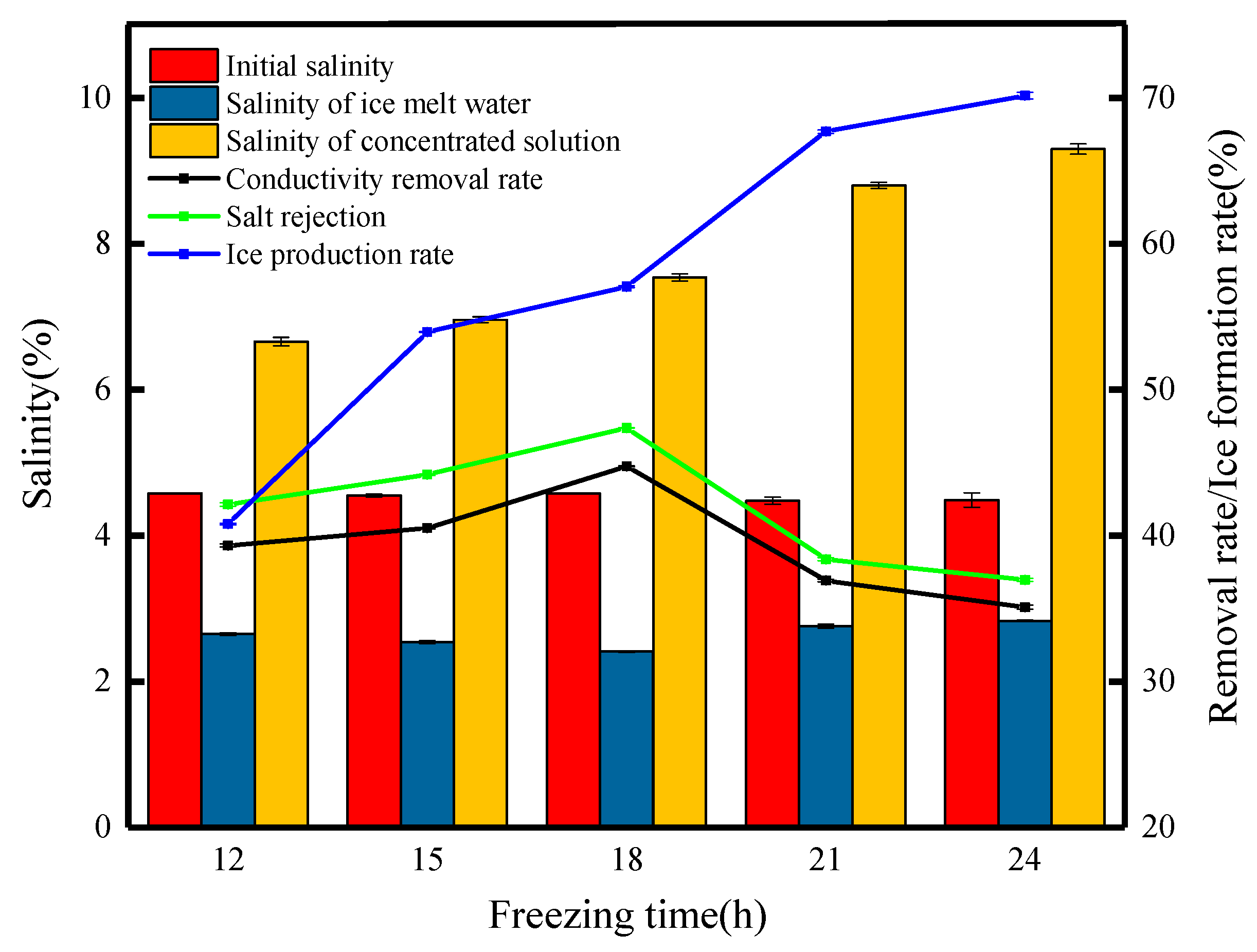
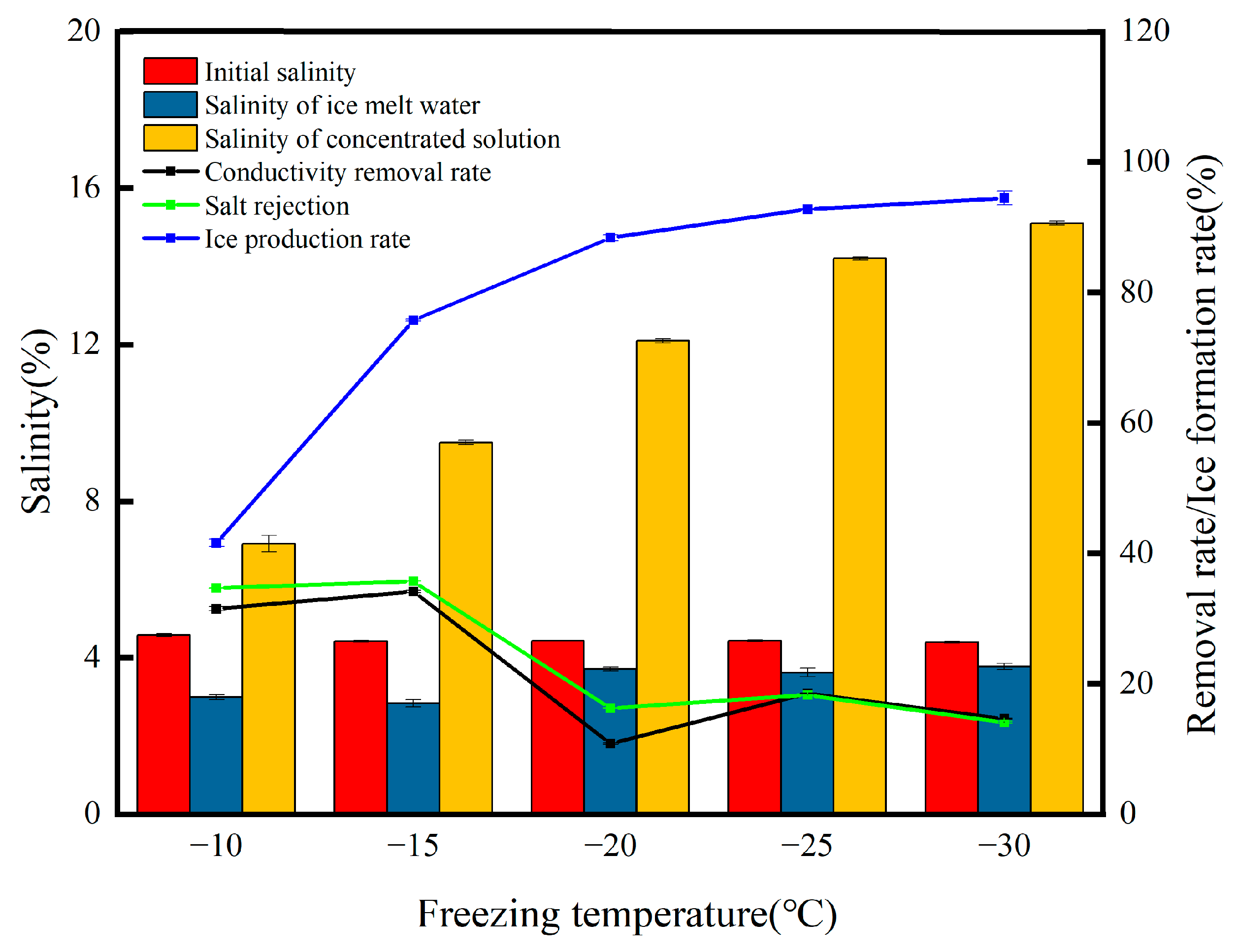
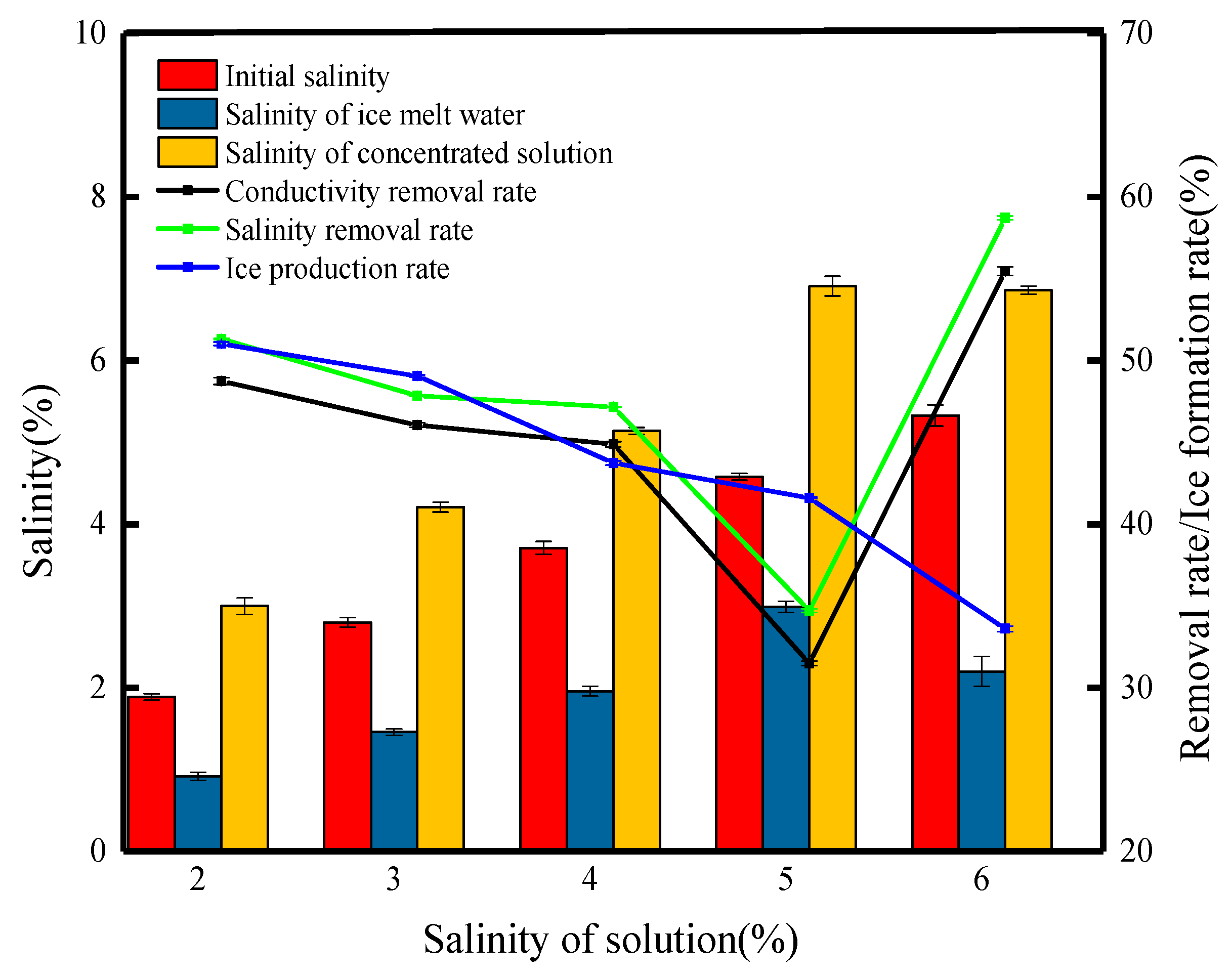
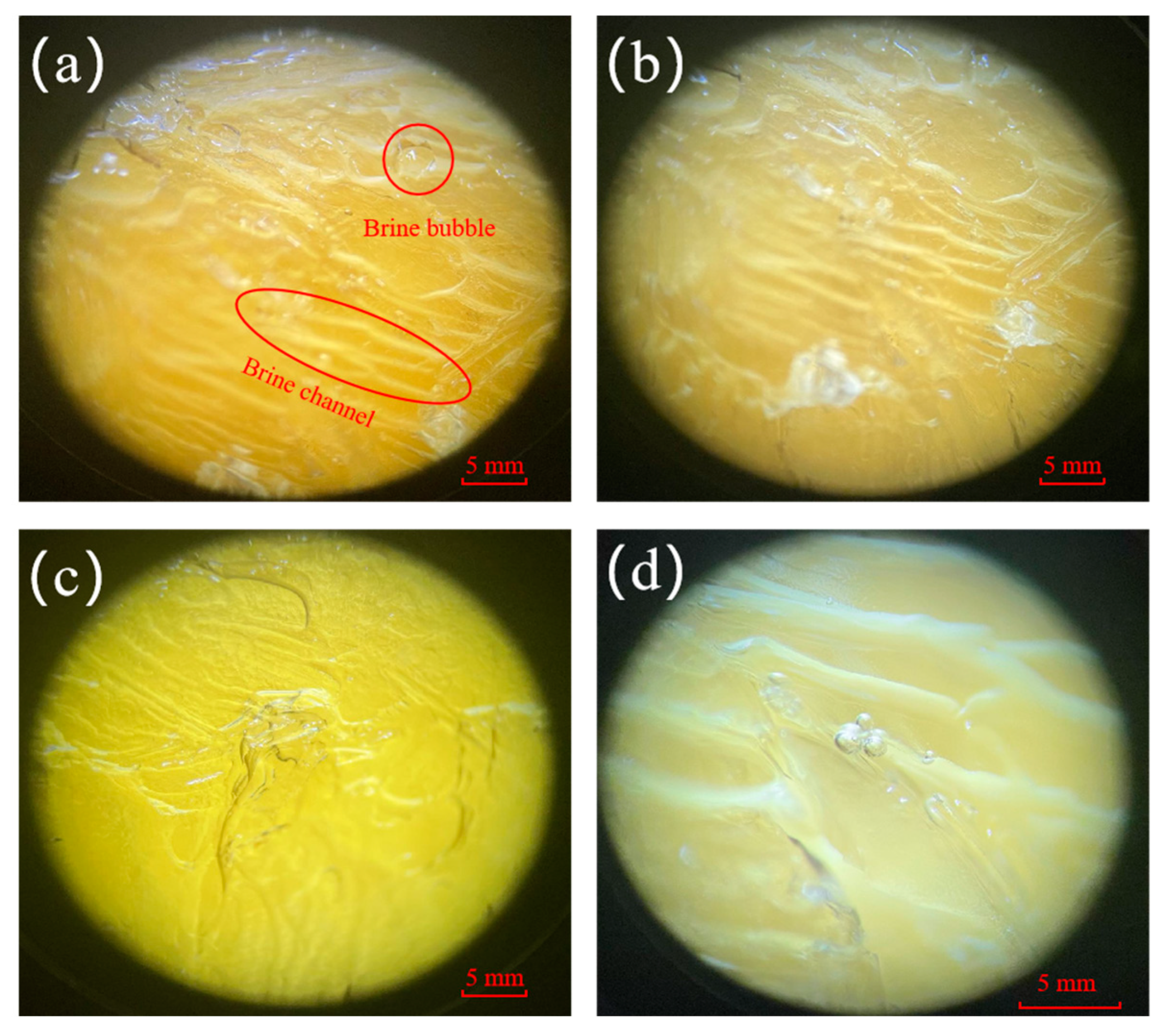

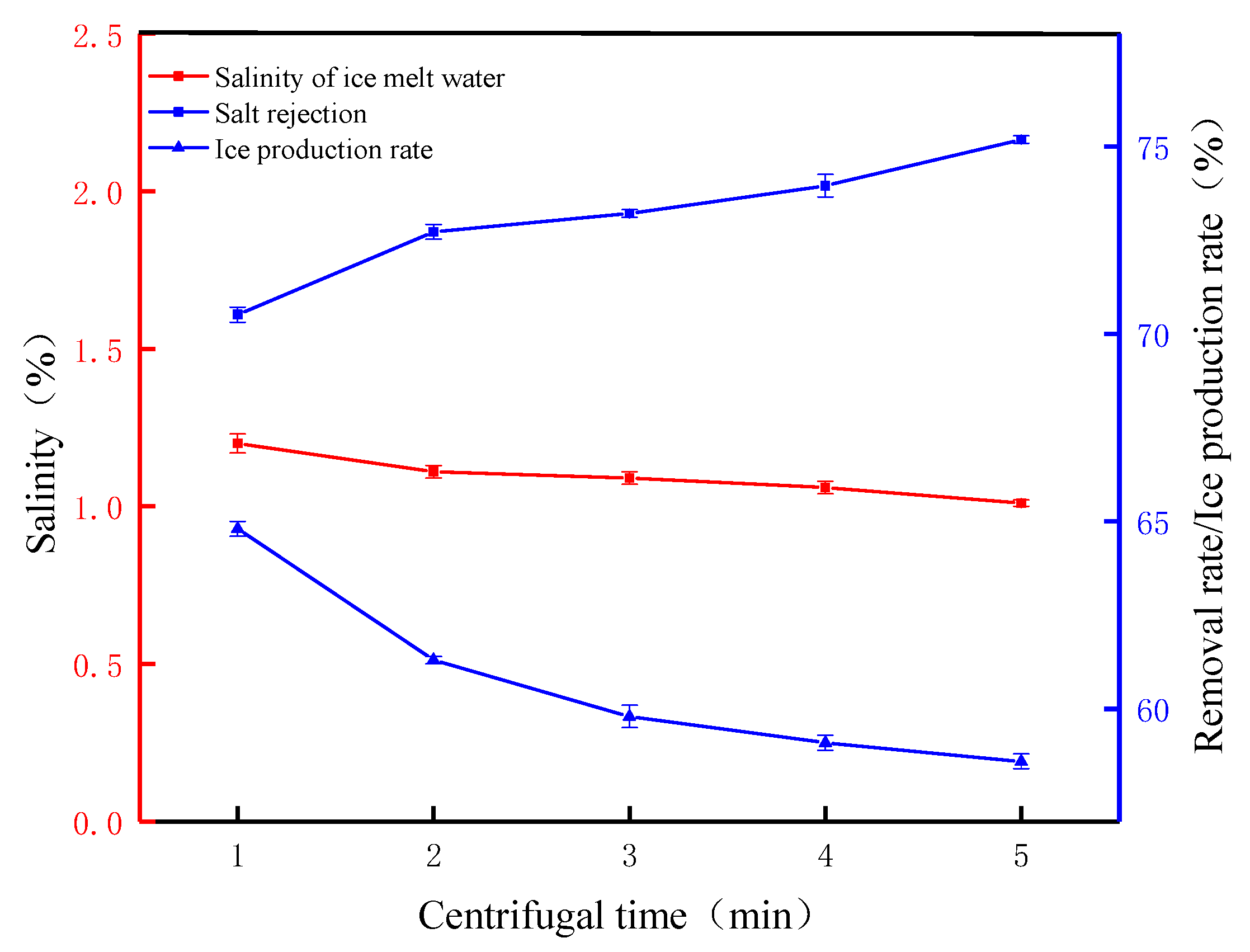



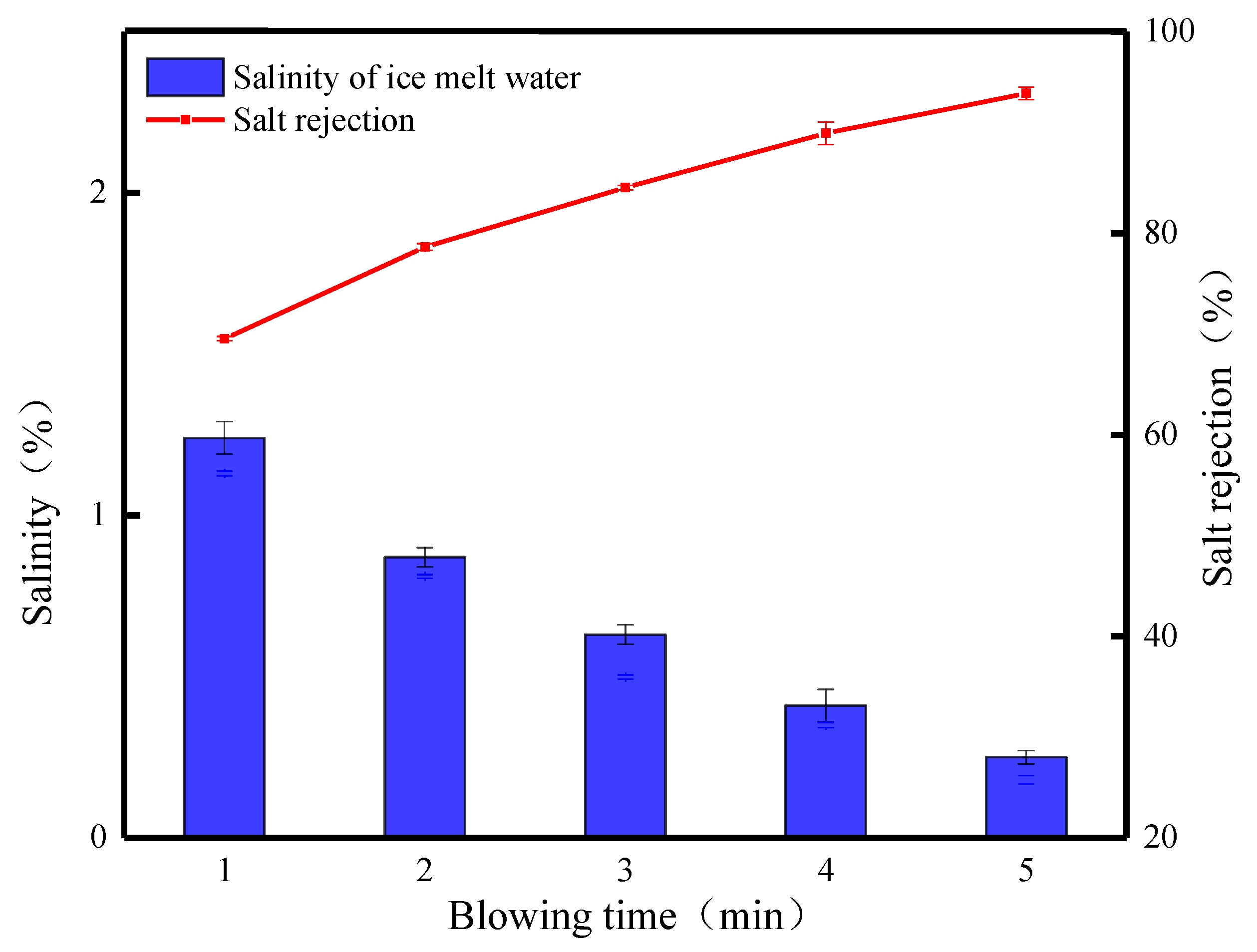
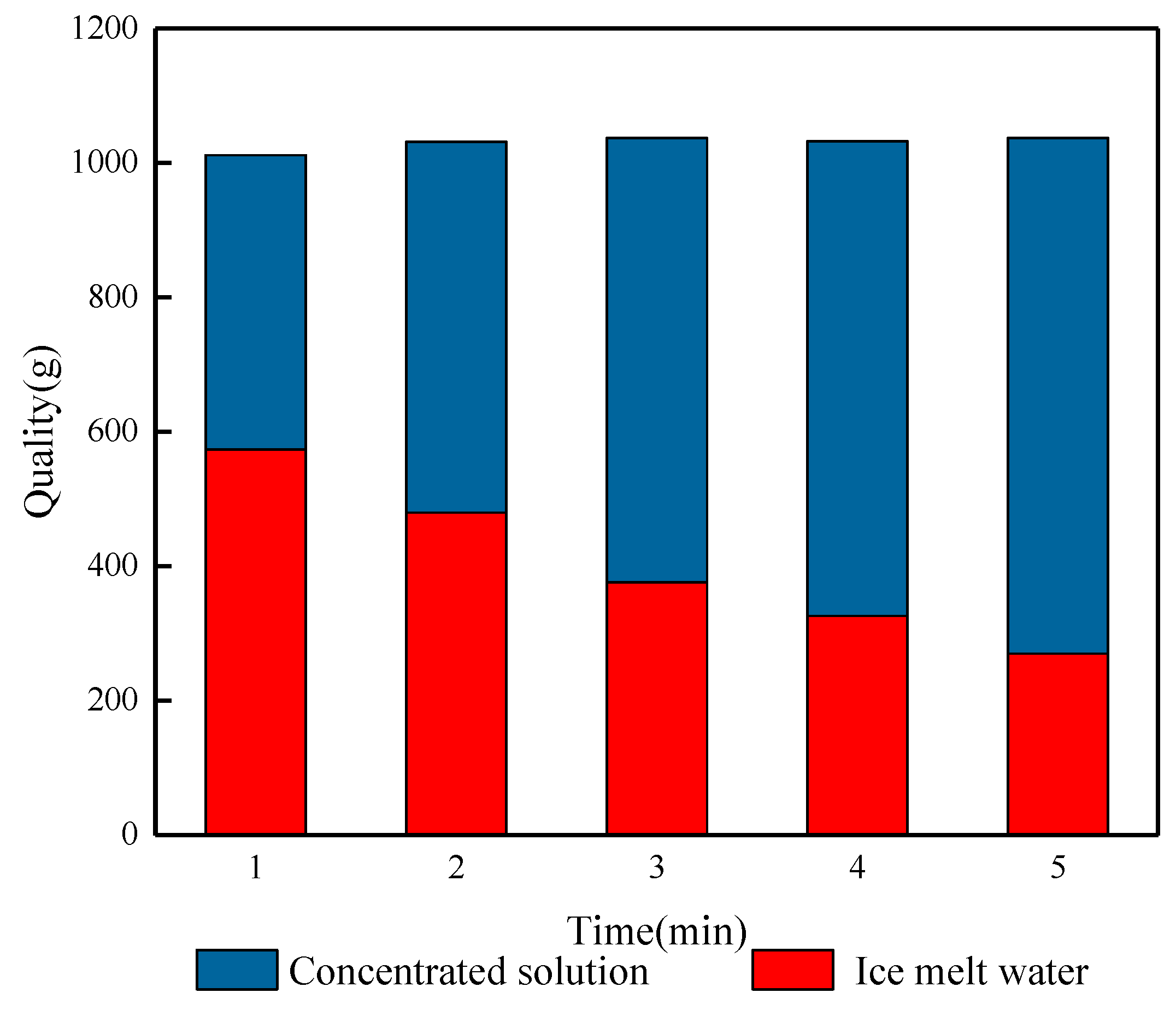
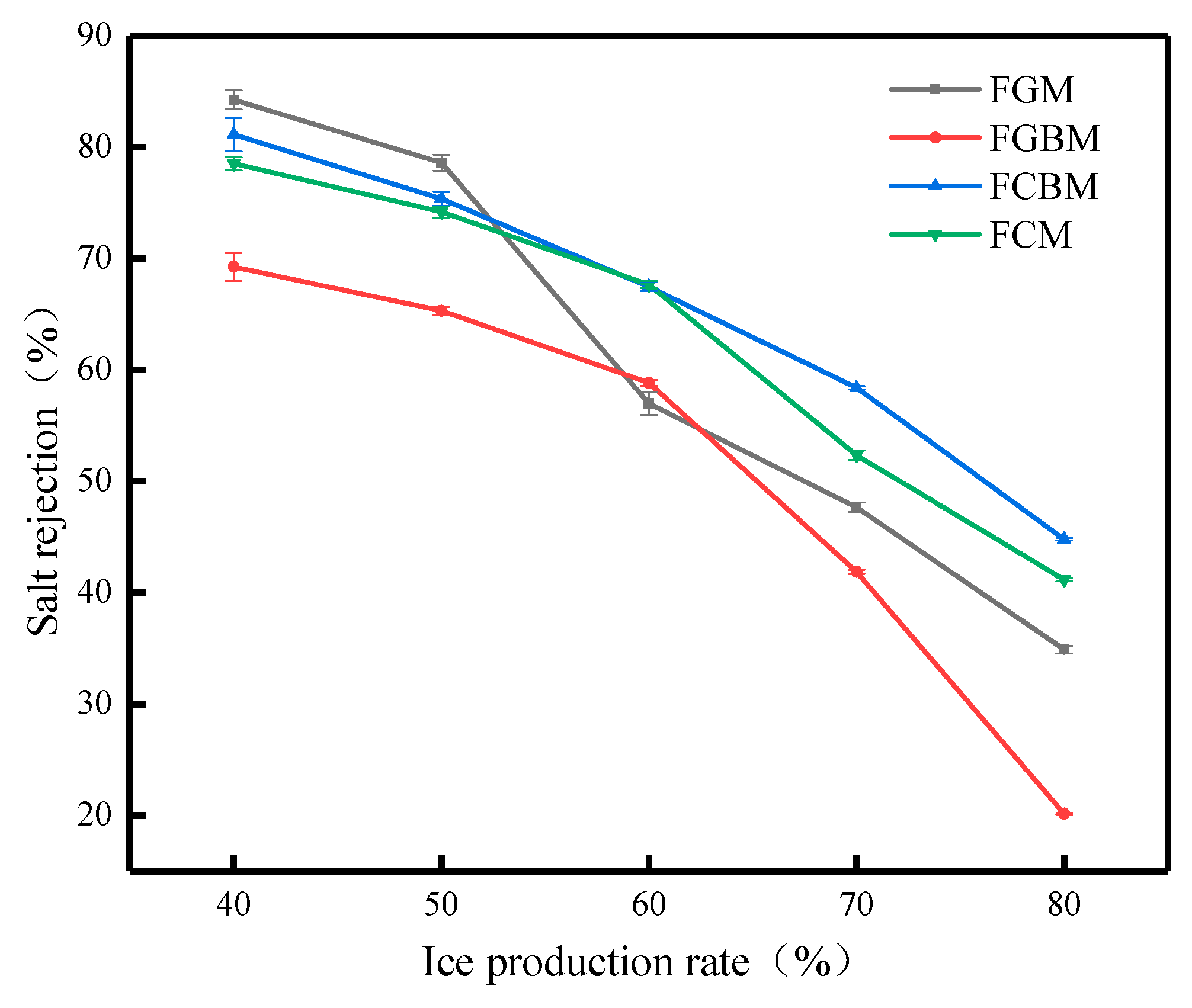
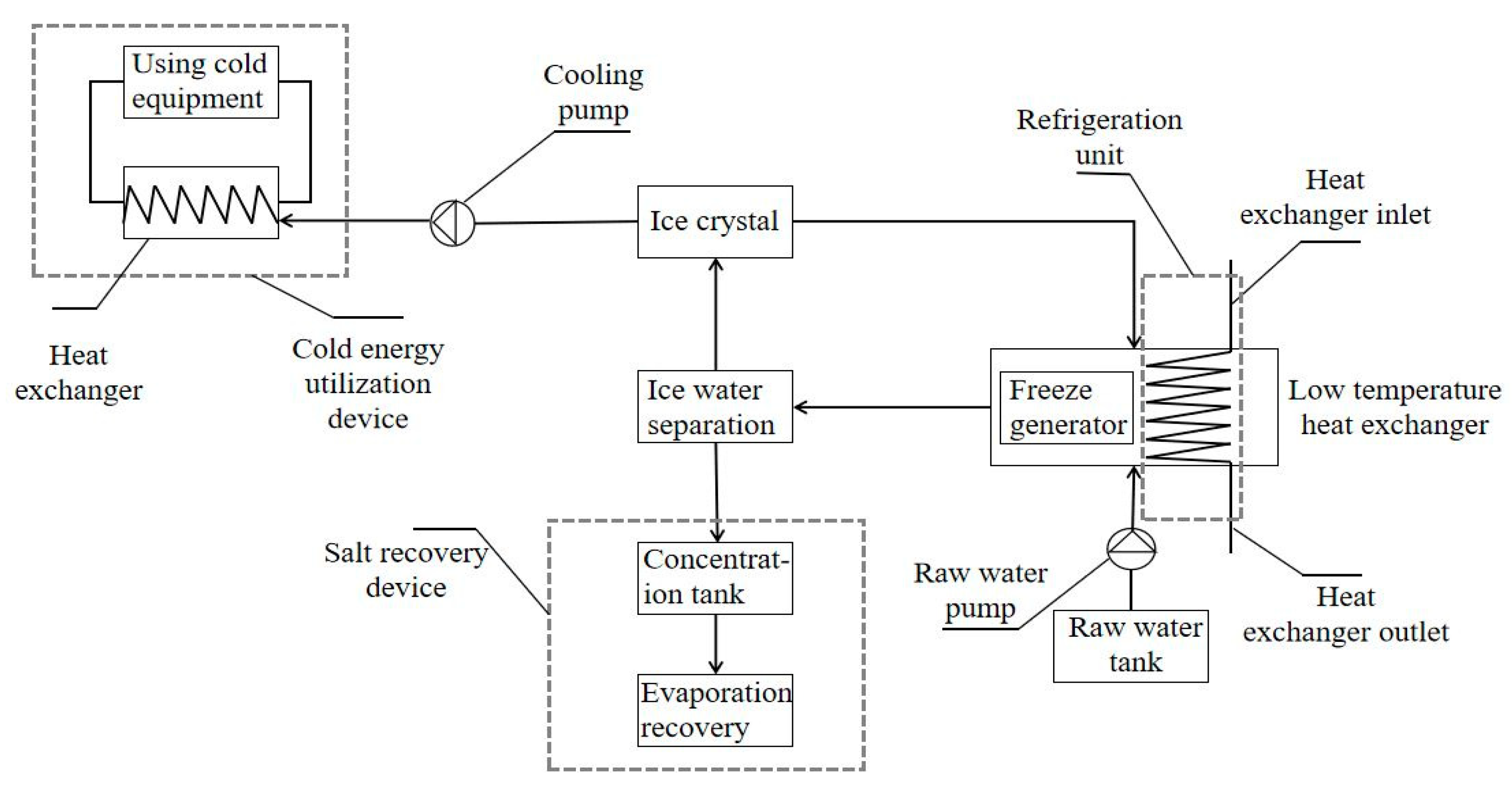
| Salinity | Cl− | SO42− | NO3− | TOC | CODcr | TDS |
|---|---|---|---|---|---|---|
| (%) | (mg/L) | (mg/L) | (mg/L) | (mg/L) | (mg/L) | (mg/L) |
| 4.07 | 18,343 | 2876 | 7310 | 1800 | 2246.1 | 32,500 |
| Process Parameter | Mean Square | F-Value | p-Value |
|---|---|---|---|
| Centrifugal time | 11.172 | 45.292 | 0.007 |
| Centrifugal speed | 608.712 | 16.747 | 0.026 |
Disclaimer/Publisher’s Note: The statements, opinions and data contained in all publications are solely those of the individual author(s) and contributor(s) and not of MDPI and/or the editor(s). MDPI and/or the editor(s) disclaim responsibility for any injury to people or property resulting from any ideas, methods, instructions or products referred to in the content. |
© 2023 by the authors. Licensee MDPI, Basel, Switzerland. This article is an open access article distributed under the terms and conditions of the Creative Commons Attribution (CC BY) license (https://creativecommons.org/licenses/by/4.0/).
Share and Cite
Wang, X.; Zhao, C.; Guo, B.; Zhang, B.; Liu, X.; Guo, Y.; Dong, Y. Experimental Study on the Desalination of Waste Leachate Using the Combined Freezing Method. Appl. Sci. 2024, 14, 36. https://doi.org/10.3390/app14010036
Wang X, Zhao C, Guo B, Zhang B, Liu X, Guo Y, Dong Y. Experimental Study on the Desalination of Waste Leachate Using the Combined Freezing Method. Applied Sciences. 2024; 14(1):36. https://doi.org/10.3390/app14010036
Chicago/Turabian StyleWang, Xiaokai, Changsheng Zhao, Beibei Guo, Bowei Zhang, Xuzhen Liu, Yanke Guo, and Yanan Dong. 2024. "Experimental Study on the Desalination of Waste Leachate Using the Combined Freezing Method" Applied Sciences 14, no. 1: 36. https://doi.org/10.3390/app14010036






